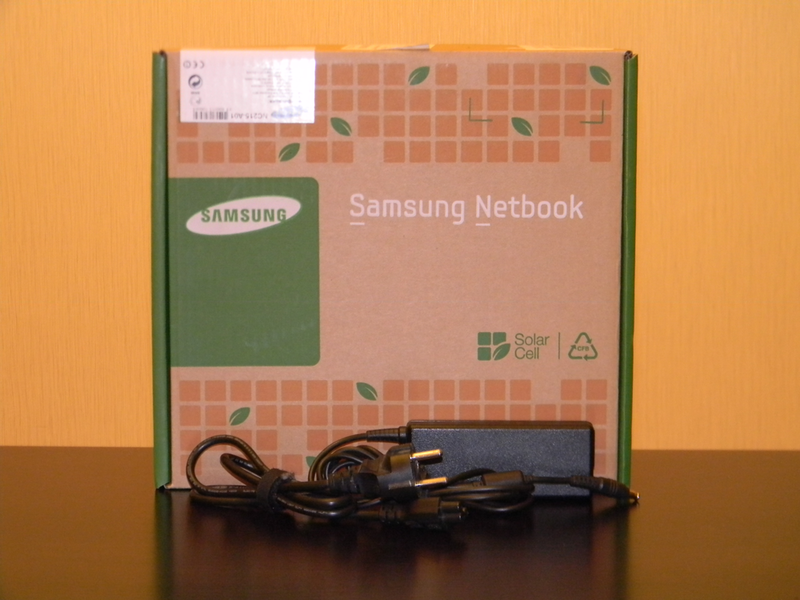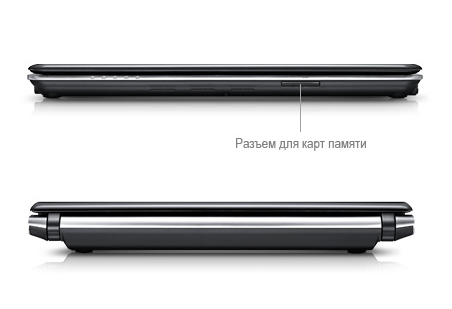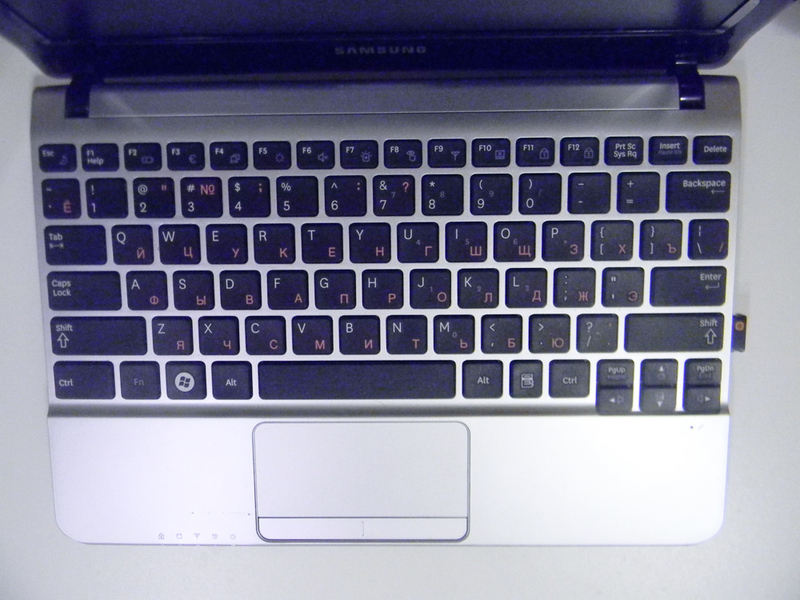Samsung NC215 Green Netbook Review
Last summer, Samsung released the world's first serial netbook, equipped with a solar battery, I was lucky to become the owner of this gadget and I want to share with you my feelings from using it.
This is my first post on Habré, in which, for the most part, there will be my subjective feelings about using a netbook in the A01RU configuration for two months, taking into account that I have been using the Samsung RF710 for more than a year, but I will try to be as close as possible objective. I apologize in advance for bad photos.
The netbook is sold in a fairly simple box, the standard package for such devices, the netbook itself, a separate battery, a power supply unit, a cable connecting the power supply unit to the power supply network and some waste paper.

')
Almost the entire outer side of the lid is occupied by a photocell under a transparent glossy plastic, painted black in its perimeter. The screen frame is made of textured glossy plastic at a fine point, in the corners there are four rubber pads, on the upper side of the frame, a peephole of a 0.3 megapixel camera.
The space under the keyboard is opaque, silver, it seems to me, it is very convenient, because it highlights the keyboard keys, the area next to the touchpad, I scratched very quickly, I remind you, I use a netbook for two months and only in isolation from the main machine. I would have liked it better if the lower part was as black as the RF710.


To the left of the touchpad are five LEDs, from left to right, Caps Lock, disk access indicator, wireless network indicator, external power indicator (orange is charging, green, battery is charged) and the power indicator, which is duplicated by the backlight button on the right side.
TFT Screen 10.1 inches with LED backlight, matte, almost does not glare and thanks to some innovative Samsung technology, color, because of this matte coating do not lose brightness, to be honest, I have nothing to compare, therefore, to say this technology works or No, I can not, take a word, but the colors are really bright, although it can be better. Aspect ratio 16: 9, screen resolution 1024x600.
Left: Power connector, LAN 10/100, USB 2.0 with charging function in sleep mode, I really like this function, since I own a smartphone on the Android OS, I am very glad that I can always charge a smartphone in the middle of the day on the way.

Right: Power button, Kensington Lock, VGA (D-Sub 15pin), two USB 2.0 ports, microphone input, headphone output.

Nothing behind, only SD card slot in front

This typewriter is not the most responsive touchpad, the scrolling area does not work immediately and generally behaves very unpredictably, multitouch gestures are supported, but only two fingers, scrolling left-right and up-down and scaling.
Keyboard island type, the same on the RF710. As I said, the keys stand out favorably on a silver background, typing in the blind is also convenient, the distance between the keys is about 4mm, which, in my opinion, is enough. There are problems with the "space" button, when with my left hand you hit the bottom left corner of the button, the space does not work, but I quickly got used to this feature.

The netbook is very quiet, especially when compared with the 17-inch laptop. I usually work for him in crowded places, sometimes even in public transport, so one can say that it does not make noise at all. The situation is similar with heating, it is heated very slightly, at least it does not burn your knees.
The netbook is equipped with an Intel NM10 chipset, which does not support HDMI and more than 2Gb of RAM, a dual-core Intel Atom N570 processor with a frequency of 1.66GHz and a 1Mb second-level cache, with Hyper Threading technology. Equipped with 2Gb DDR3 RAM with a frequency of 1066MHz (single slot). Integrated Intel GMA 3150 graphics accelerator with 256Mb of memory. As for performance, I can’t say a lot, I didn’t communicate with other netbooks, but this one seemed rather nimble to me, although it happens, it slows down, but if you don’t overload it with unnecessary processes, it works fine.
The kit includes a 6-cell lithium-ion rechargeable battery with a capacity of 8850 mAh, which according to the manufacturer must keep for 14.5 hours. According to my observations, this indicator is very close to reality, with an average intensity of use (on the day ~ 1 hour on the Internet, 0.5 hours of watching a video and about 1.5 hours of writing, the rest of the time I used adult computers) in “balanced” In this mode, I charged my netbook once every four days, and at the same time I never waited for a complete shutdown, I put on charge, at night, so that in the morning it was full of strength and ready for use. Charges pretty quickly, I can’t give exact figures, it happened once that I forgot to put it on overnight for charging and decided to charge it in the morning, before work, it was enough for an hour to charge it in half. The manufacturer also claims that Samsung PowerPlus intelligent charging technology allows the battery to save 80% of the original capacity for about 1000 charges, I hope, the numbers here are also close to reality. I didn’t succeed in checking the operation of the solar battery; after all, it’s quite difficult to do this in St. Petersburg in winter, but I’m going to Thailand in March, I’ll check it there (if someone doesn’t do it before) and I’ll tell you about it either or in my blog, as the habrasoobschestvu wish. While I made a couple of synthetic measurements using the Eco Mode program, a 100 watt searchlight, with a direct hit from a distance of 25 cm, produced 0.247 watts of power, 500 watts from the same distance of 1.020 watts, despite the fact that power consumption in the “balanced” mode is 9-10 watts.
The netbook is running Windows 7 in Starter / Starter edition, so far I have left everything as it is, maybe later, I’ll install Ubuntu before this happens. The kit includes some samsung programs, Control Center, Fast Start, Recovery Solution 5, Update Plus, Easy File Share, Easy Content Share and Eco Mode. The latter is a conventional mode switch, there are four to choose from, “environmental protection”, this mode is the most curtailed, “energy saving”, a little less curtailed, “Functioning without disturbing the natural balance”, “normal” mode, and customizable “Setup for specific tasks. " The mode is configured separately for battery operation and for network operation, you can customize the power management scheme, “sleep mode”, “standby mode” and switch the processor in sleep mode. Screen settings, “dimming time”, “screen off”, and “brightness level”. And a few more switches on / off, "charging USB", "wireless network", "Bluetooth". The same program can show current power consumption, CO2 emissions and charge power from the solar battery (when the power cable is disconnected).

The device turned out very successful, I do not regret how much money was spent on it, but I spent a little more than 14,000 rubles. Excellent keyboard, good screen, 320Gb hard drive, very good battery life and solar battery bribed me. Another would be to live where this solar battery can be used as it should be, but that’s another story.
UPD: Judging by the reviews, the habra people did not like my post, those who are interested in continuing here
Foreword
This is my first post on Habré, in which, for the most part, there will be my subjective feelings about using a netbook in the A01RU configuration for two months, taking into account that I have been using the Samsung RF710 for more than a year, but I will try to be as close as possible objective. I apologize in advance for bad photos.
Contents of delivery
The netbook is sold in a fairly simple box, the standard package for such devices, the netbook itself, a separate battery, a power supply unit, a cable connecting the power supply unit to the power supply network and some waste paper.

')
Appearance
Almost the entire outer side of the lid is occupied by a photocell under a transparent glossy plastic, painted black in its perimeter. The screen frame is made of textured glossy plastic at a fine point, in the corners there are four rubber pads, on the upper side of the frame, a peephole of a 0.3 megapixel camera.
The space under the keyboard is opaque, silver, it seems to me, it is very convenient, because it highlights the keyboard keys, the area next to the touchpad, I scratched very quickly, I remind you, I use a netbook for two months and only in isolation from the main machine. I would have liked it better if the lower part was as black as the RF710.


To the left of the touchpad are five LEDs, from left to right, Caps Lock, disk access indicator, wireless network indicator, external power indicator (orange is charging, green, battery is charged) and the power indicator, which is duplicated by the backlight button on the right side.
Screen
TFT Screen 10.1 inches with LED backlight, matte, almost does not glare and thanks to some innovative Samsung technology, color, because of this matte coating do not lose brightness, to be honest, I have nothing to compare, therefore, to say this technology works or No, I can not, take a word, but the colors are really bright, although it can be better. Aspect ratio 16: 9, screen resolution 1024x600.
Interfaces
Left: Power connector, LAN 10/100, USB 2.0 with charging function in sleep mode, I really like this function, since I own a smartphone on the Android OS, I am very glad that I can always charge a smartphone in the middle of the day on the way.

Right: Power button, Kensington Lock, VGA (D-Sub 15pin), two USB 2.0 ports, microphone input, headphone output.

Nothing behind, only SD card slot in front

Hid
This typewriter is not the most responsive touchpad, the scrolling area does not work immediately and generally behaves very unpredictably, multitouch gestures are supported, but only two fingers, scrolling left-right and up-down and scaling.
Keyboard island type, the same on the RF710. As I said, the keys stand out favorably on a silver background, typing in the blind is also convenient, the distance between the keys is about 4mm, which, in my opinion, is enough. There are problems with the "space" button, when with my left hand you hit the bottom left corner of the button, the space does not work, but I quickly got used to this feature.

Noise, heating
The netbook is very quiet, especially when compared with the 17-inch laptop. I usually work for him in crowded places, sometimes even in public transport, so one can say that it does not make noise at all. The situation is similar with heating, it is heated very slightly, at least it does not burn your knees.
Performance
The netbook is equipped with an Intel NM10 chipset, which does not support HDMI and more than 2Gb of RAM, a dual-core Intel Atom N570 processor with a frequency of 1.66GHz and a 1Mb second-level cache, with Hyper Threading technology. Equipped with 2Gb DDR3 RAM with a frequency of 1066MHz (single slot). Integrated Intel GMA 3150 graphics accelerator with 256Mb of memory. As for performance, I can’t say a lot, I didn’t communicate with other netbooks, but this one seemed rather nimble to me, although it happens, it slows down, but if you don’t overload it with unnecessary processes, it works fine.
Work time charging
The kit includes a 6-cell lithium-ion rechargeable battery with a capacity of 8850 mAh, which according to the manufacturer must keep for 14.5 hours. According to my observations, this indicator is very close to reality, with an average intensity of use (on the day ~ 1 hour on the Internet, 0.5 hours of watching a video and about 1.5 hours of writing, the rest of the time I used adult computers) in “balanced” In this mode, I charged my netbook once every four days, and at the same time I never waited for a complete shutdown, I put on charge, at night, so that in the morning it was full of strength and ready for use. Charges pretty quickly, I can’t give exact figures, it happened once that I forgot to put it on overnight for charging and decided to charge it in the morning, before work, it was enough for an hour to charge it in half. The manufacturer also claims that Samsung PowerPlus intelligent charging technology allows the battery to save 80% of the original capacity for about 1000 charges, I hope, the numbers here are also close to reality. I didn’t succeed in checking the operation of the solar battery; after all, it’s quite difficult to do this in St. Petersburg in winter, but I’m going to Thailand in March, I’ll check it there (if someone doesn’t do it before) and I’ll tell you about it either or in my blog, as the habrasoobschestvu wish. While I made a couple of synthetic measurements using the Eco Mode program, a 100 watt searchlight, with a direct hit from a distance of 25 cm, produced 0.247 watts of power, 500 watts from the same distance of 1.020 watts, despite the fact that power consumption in the “balanced” mode is 9-10 watts.
Software
The netbook is running Windows 7 in Starter / Starter edition, so far I have left everything as it is, maybe later, I’ll install Ubuntu before this happens. The kit includes some samsung programs, Control Center, Fast Start, Recovery Solution 5, Update Plus, Easy File Share, Easy Content Share and Eco Mode. The latter is a conventional mode switch, there are four to choose from, “environmental protection”, this mode is the most curtailed, “energy saving”, a little less curtailed, “Functioning without disturbing the natural balance”, “normal” mode, and customizable “Setup for specific tasks. " The mode is configured separately for battery operation and for network operation, you can customize the power management scheme, “sleep mode”, “standby mode” and switch the processor in sleep mode. Screen settings, “dimming time”, “screen off”, and “brightness level”. And a few more switches on / off, "charging USB", "wireless network", "Bluetooth". The same program can show current power consumption, CO2 emissions and charge power from the solar battery (when the power cable is disconnected).

Conclusion
The device turned out very successful, I do not regret how much money was spent on it, but I spent a little more than 14,000 rubles. Excellent keyboard, good screen, 320Gb hard drive, very good battery life and solar battery bribed me. Another would be to live where this solar battery can be used as it should be, but that’s another story.
UPD: Judging by the reviews, the habra people did not like my post, those who are interested in continuing here
Source: https://habr.com/ru/post/134353/
All Articles